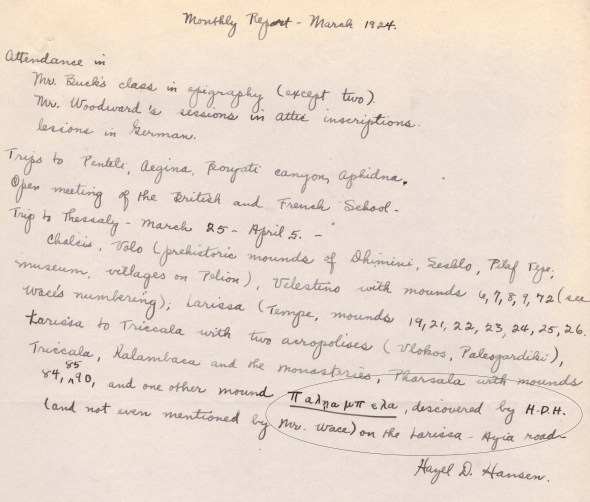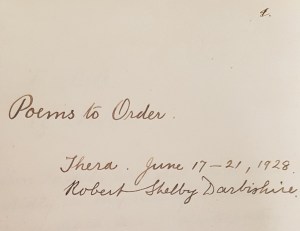Where There’s Smoke There’s Fire: De Waele’s Story
Posted: February 7, 2021 Filed under: Archaeology, Archival Research, Biography, Classics, History of Archaeology | Tags: Ferdinand Joseph Maria de Waele, Louis E. Lord, Oscar Broneer, Richard Stillwell 8 CommentsThe jumping-off point for this story was an odd comment that Louis E. Lord made in his History of the American School of Classical Studies at Athens about a Belgian archaeologist who was active at the School from 1927 until 1934. “Ferdinand Joseph Maria de Waele, Assistant in Archaeology for six years (1929-1934) was not reappointed. He had served well as an excavator, his work at the Asklepieion had been competent. But he never made a final report for publication, and the manner of his departure left behind him an odor of unsanctity highly offensive to the School” (Lord 1947, p. 246). Lord was referring to an accusation of smuggling antiquities made against de Waele. But was it true? A simple Google search showed that Ferdinand Joseph Maria De Waele (1896-1977), after leaving the American School, went on to have a distinguished career as a professor of archaeology at the Catholic University of Nijmegen in the Netherlands and, later, at the University of Ghent.

Forgotten Friend of Skyros: Hazel D. Hansen (Part II)
Posted: May 14, 2020 Filed under: Archaeology, Archival Research, Biography, Classics, Greek Folklore, History of Archaeology, Philhellenism, Women's Studies | Tags: Brunilde Sismondo Ridgway, Francis Bertram Welch, Hazel D. Hansen, Oscar Broneer, Stanford University 2 CommentsAs a young woman, Hazel Dorothy Hansen broke several glass ceilings. From a humble background –her father was a foundryman—she was admitted to Stanford University in 1916, at a time when the institution had severely limited the admission of women. In 1904, Mrs. Stanford became afraid of the increasing number of women enrolling at Stanford (by 1899 reaching almost 40% of the student population) and implemented a quota that restricted their numbers at the undergraduate level: for every woman at Stanford, there had to be three men. (See Sam Scott, “Why Jane Stanford Limited Women’s Enrollment to 500,” Stanford Magazine, Aug. 22, 2018.). Fortunately for a girl of modest means, Stanford remained tuition-free until 1920.
She broke the glass ceiling again when she chose a prehistoric topic for her dissertation (“Early Civilization in Thessaly”) that also required extensive surveying for sites on the Greek periphery. In the 1920’s female graduate students at the American School had limited options when it came to field research. Apart from Alice Leslie Walker, who had been entrusted with the publication of its Neolithic pottery, Corinth remained a male domain, with Bert Hodge Hill and Carl W. Blegen controlling access to, and publication of, archaeological material. Hazel would have needed either to finance her own excavation, as Hetty Goldman and Walker had done in the 1910s, or to write an art history thesis based on material in museums. It was not until David R. Robinson began excavations at Olynthus and Edward Capps spearheaded the Athenian Agora Excavations that women were allowed to participate in the publication of (secondary) excavation material.

Hansen’s monthly report (March 1924) to the School’s Director, where she lists her trips, and also proudly claims that she discovered the prehistoric site of Μαγούλα Παλιάμπελα (“and not even mentioned by Mr. Wace”). ASCSA Archives, AdmRec 108/1, folder 5.
Exploring the Relationship of the American School of Classical Studies at Athens with the Greek Omogeneia in the United States in the 1940s.
Posted: July 4, 2019 Filed under: Archaeology, Archival Research, Biography, History of Archaeology, Mediterranean Studies, Modern Greek History, Philhellenism | Tags: American School of Classical Studies at Athens, Greek War Relief Association, Nikolaos Mavris, Omogeneia, Oscar Broneer, Spyros Skouras, Theodore Leslie Shear, Triumph Over Time 7 CommentsIn 1947, the American School of Classical Studies at Athens (ASCSA or the School hereafter) produced a color movie titled Triumph over Time; it was directed by the archaeologist Oscar Broneer and produced by the numismatist Margaret E. Thompson with the aid of Spyros Skouras (1893-1971), the Greek American movie mogul and owner of Twentieth Century Fox (see Spyros Skouras Papers at Stanford University). Triumph over Time portrays Greece rebounding from World War II and the staff of the ASCSA preparing archaeological sites for presentation to postwar tourists. The film was made to promote the first postwar financial campaign of the ASCSA, the direct goal of which was to increase its capital and finance the continuation of the Athenian Agora Excavations. Indirectly, the ASCSA was hoping to contribute to the rehabilitation of Greece by providing employment for the Greek people and by promoting the economic self-sufficiency of Greece by developing the country’s tourist assets (Vogeikoff-Brogan 2007).

Oscar Broneer, ca. 1938. ASCSA Archives, Oscar Broneer Papers.
Triumph over Time begins with a brief overview of impressive Greek antiquities, such as the citadels of Mycenae and Tiryns and the Temple of Poseidon at Sounion, before continuing with rare ethnographic material capturing parts of rural Greece that no longer exist. It then moves from the Greek countryside to the buildings of the ASCSA, especially the Gennadius Library with its rare treasures. The story then covers the ASCSA’s two most important projects, the excavations at the Athenian Agora and at Ancient Corinth, explaining all stages of archaeological work. The documentary ends with a hopeful note that financial support of the ASCSA’s archaeological work will contribute to an increase in tourism so that this major source of revenue for Greece’s economy can “restore stability and well-being to this simple pastoral land.”

Stills from Triumph Over Time
Connecting the Dots: Peripheral Figures in the History of the American School of Classical Studies. The Case of R. S. Darbishire.
Posted: November 2, 2018 Filed under: Archaeology, Archival Research, Biography, History of Archaeology, Modern Greek History, Philhellenism | Tags: Arnold J. Toynbee, Athens College, Elizabeth Darbishire McNeill, Oscar Broneer, Robert S. Darbishire, William H. McNeill 14 CommentsRevised on July 30, 2022, following communication with the McNeill family. See my endnote.
Steve Jobs once said: “You can’t connect the dots looking forward; you can only connect them looking backwards.” Archives is all about connecting the dots. When processing archival material, you often come across documents, photos, or notes that don’t connect in any obvious way with the rest. For this reason, all finding aids have a “Miscellaneous” section. And such is the case of R. S. Darbishire (1886-1949), a name I came upon in the Carl W. Blegen Papers several years ago, in a booklet of poems; and more recently, while going through a small box of unprocessed material from the Blegen/Hill household on Ploutarchou 9, in a set of architectural blueprints. It took me a while to connect the dots in the Darbishire puzzle.
The Elusive Mr. Darbishire

ASCSA Archives, Carl W. Blegen Papers
In the Blegen Papers, there is a small booklet with a collection of handwritten poems titled “Poems to Order. Thera, June 17-21, 1928. Robert Shelby Darbishire.” The short poem on the first page is dedicated to CB:
Εξ αδοκήτο [Unforeseen]
You, when I asked, “What shall I do in Thera?”
Unexpectedly in my empty mind
Casually dropped this: “Write pretty!”
Here (unexpectedly) nought else I find.
Darbishire appears in the student list of the American School of Classical Studies (ASCSA, or School hereafter) for the year 1926-27; he is also thanked in the preliminary reports or final publications of a number of excavations conducted in 1927-1928: Prosymna, the Odeum at Corinth, and Olynthus.
There is very little information about Robert Shelby Darbishire on the web, and one has to type his name in various ways in order to retrieve a few scraps. Born in 1886 at Fort Meade, Florida, he was the son of Godfrey Darbishire (1853-1889) -a British surveyor and a famous rugby player, who immigrated to the States in 1883– and Ann Shelby of Lincoln, Kentucky. Robert was unfortunate to lose his father at an early age. Mother and son lived for a while on a farm they owned in Danville, Kentucky before they moved back to England to be near the paternal side of the family. (Darbishire’s grandfather was Robert Dukinfield Darbishire, a well-known philanthropist and lawyer from Manchester.) Nevertheless, the Kentucky farm remained in the Darbishire family’s possession for a long time; mother and son would move back to it after the death of Robert Dukinfield in 1910; and Robert Shelby would retreat to the farm in various periods of his life. In fact, the family papers are deposited at the University of Kentucky Special Collections, and it is from their finding-aid that I managed to obtain good and reliable information about the Darbishires.
“Dollars and Dreams”: American Archaeologists on the Hunt for Greek American Money in Chicago
Posted: July 2, 2016 Filed under: Archival Research, History of Archaeology, Modern Greek History, Philhellenism | Tags: American School of Classical Studies at Athens, Chicago University, George Bourlos, Gertrude E. Smith, John L. Manta, Oscar Broneer Leave a comment
A still from The Aunt from Chicago (Η θεία από το Σικάγο) with the eccentric Greek American aunt (played by Georgia Vasileiadou) in the middle.
The Aunt from Chicago is one of the most beloved films in the history of Greek cinema. Produced in 1957, it became an instant hit and remained in demand for many decades. The movie had all the ingredients of a successful production: a great set and superior performances by the best actors of its time. As much as the film is a satire on the conservatism of the Greek family, it is also a subtle mockery of the “aunt’s” Americanization.
Proud of their successful relatives in America, but also feeling uncomfortable with their rapid assimilation by American culture, Greek intellectuals such as novelists Elias Venezis and Yorgos Theotokas tried to rationalize the loss of national identity by the Greek migrants. If, before WW II, stories of hardship and suffering prevailed over stories of success, after the war America’s new supremacy left little room for a narrative of failure. Instead, a new transnational narrative wanted Greek migrants — with their age-old values and in light of the bravery they had demonstrated during the war — to have contributed to the building of a new America. Novelist Yorgos Theotokas in his Essay on America (Δοκίμιο για την Αμερική), in the wake of a visit to the United States in 1953, would go so far as to claim that “From now on, the American people will be—to a small, but considerable extent—descendants of Greeks also” (Laliotou 2004, p. 86). (For a thorough study of the Greek migration in America, see Ioanna Laliotou, Transatlantic Subjects: Acts of Migration and Cultures of Transnationalism between Greece and America, Chicago 2004.)

